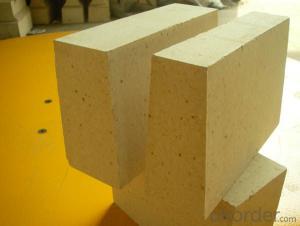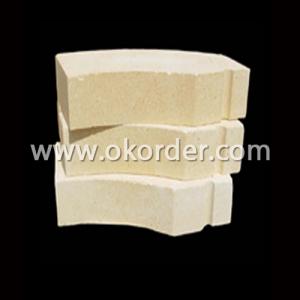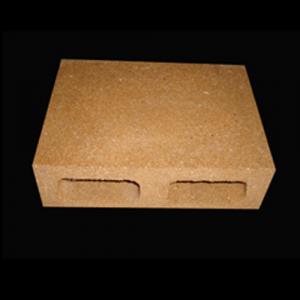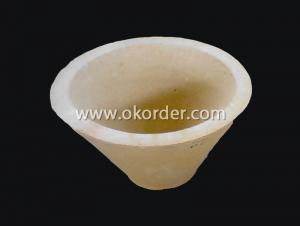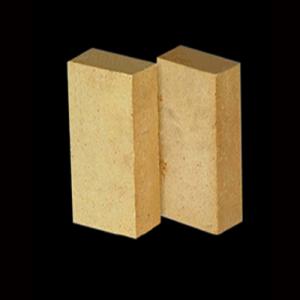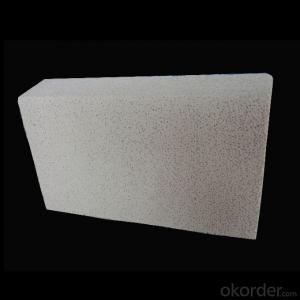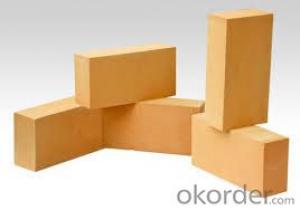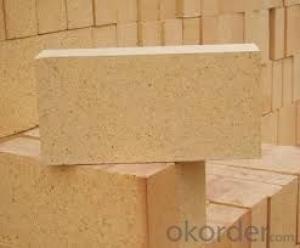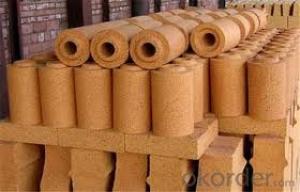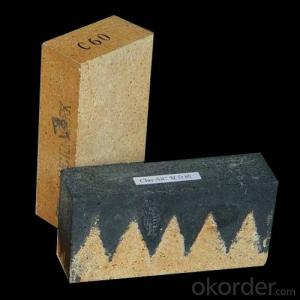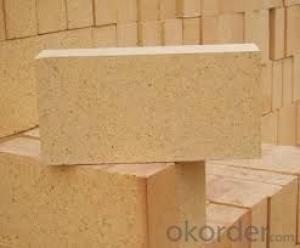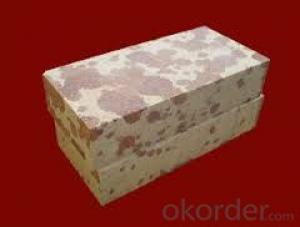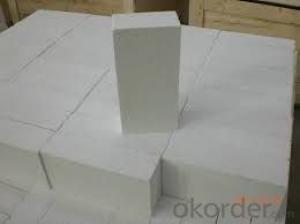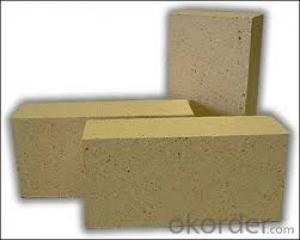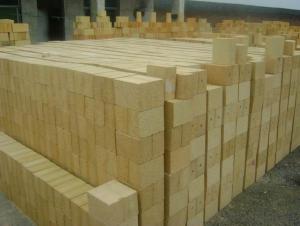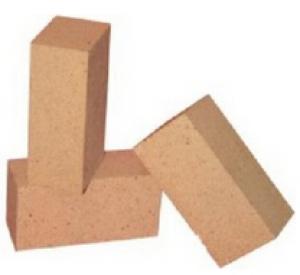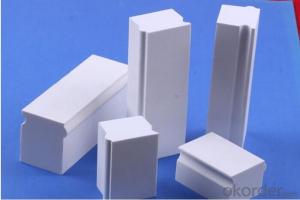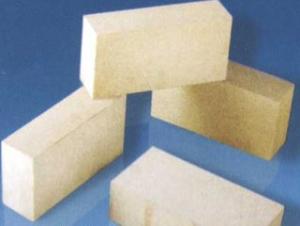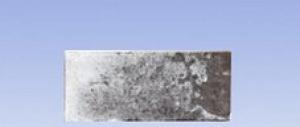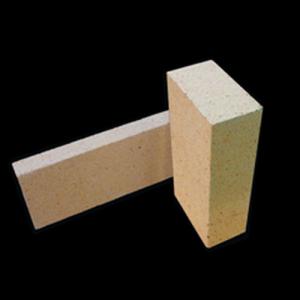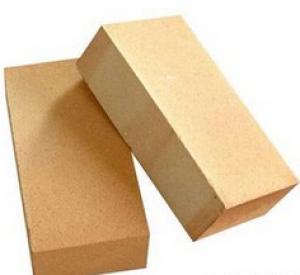High Alumina Lightweight Refractory Brick for Glass Melting Furnace
- Loading Port:
- Shanghai
- Payment Terms:
- TT OR LC
- Min Order Qty:
- 1 m.t.
- Supply Capability:
- 111 m.t./month
OKorder Service Pledge
OKorder Financial Service
You Might Also Like
Specifications
1. Low bulk density;
2.high cold crushing strength;
3. lowest thermal conductivity.
High alumina lightweight insulating refractory brick
Application
By using the products widely in insulating layers of various thermal equipments for example blast furnace, hot blast furnace, coke oven and linings where no high temperatures melt corrosion occurs.
Features:
Characterized by low bulk density, maximum service temperature is 1350C., high cold crushing strength, size precision and hold the most stable and lowest thermal conductivity of all insulating refractory bricks at present.
The total weight of the furnace body and walls thickness can be reduced effectively, thermal efficiency and working condition can be improved, energy consumption can be lowered, and productivity and significant economic results can be achieved.
High alumina lightweight insulating refractory brick is a kind of insulation material adopting organic matter as ignition loss substance in order to increase the porosity of refractory, which has such advantages as high porosity, small volume density, good insulation effect, high mechanical intensity, small thermal conductivity and long service life. For various industrial kilns & furnaces, it is a kind of essential refractory for energy saving and temperature preservation.
Composition
This series of High Alumina Insulating Refractory Brick are made of selected high alumina bauxite, kaolin clay, and hollow microsphere. By shaping at high pressure and sintering at high temperature
Physical and chemical index
Brand Inedx | HG-1.2 | LG-1.0 | LG-0.9 | LG-0.8 | LG-0.7 | LG-0.6 | LG-0.5 |
Al2O3,% | ≥48 | ||||||
Fe2O3,% | ≤2.0 | ||||||
Bulk Density ≤ | 1.2 | 1.0 | 0.9 | 0.8 | 0.7 | 0.6 | 0.5 |
Cold Crushing Strength ≥ | 5 | 3.92 | 3.43 | 2.94 | 2.45 | 1.96 | 1.47 |
(350°C)W/m.K Thermal Conductivity ≤ | 0.55 | 0.5 | 0.45 | 0.35 | 0.35 | 0.30 | 0.25 |
Temp reheating shrinkage less than 2.0% | 1400 | 1400 | 1400 | 1400 | 1350 | 1350 | 1250 |
- Q: What's the difference between a well type annealing furnace and a box type annealing furnace?
- Box annealing furnace application: mainly used for quenching, normalizing, annealing and other conventional heat treatment equipment for steel parts. Features: 1, electric loading, high productivity, heat treatment is especially suitable for small and medium-sized parts, such as 30%, uniform temperature, intelligent digital display meter PID (pictured) automatic temperature control, high precision; 2, electric discharge loading convenient, as good; 3, door and seal the oven body is sealed automatically, without manual seal; 4, equipped with electric interlock protection device, and can prevent the fault accident due to the error. Bell type annealing furnace four bell type annealing furnace bell type annealing furnace is mainly used for annealing sheet metal in natural atmosphere and normalizing treatment of steel parts. 1, special steel, precision alloy large all fiber trolley type resistance furnace, strip, wire bright annealing. 2 、 annealing of special steel casting and forging. 3. Annealing of silicon steel sheet. 4, metal and non metal powder sintering pieces etc..
- Q: Aluminum content 38, silicon content 55 What refractory bricks?
- Semisilica brick: the content of Al2O3 is 15% ~ 30% of aluminium silicate refractory products. Manufacturing products are semi silica quartz containing impurities or native clay kaolin, refractory clay or kaolin beneficiation tailings and the pyrophyllite
- Q: Difference between low creep high alumina brick and ordinary high alumina brick
- The question is good, these two belong to the high aluminum brick products, when many manufacturers buy, I do not know how to distinguish.
- Q: How to reduce porosity of high alumina brick
- When proportioning, the ratio of coarse to medium to fine is 4:2:4, and the maximum particle size should be no more than 5mm. The mixing order is as follows: first adding coarse particles, then adding sulfite pulp waste liquid, premixed 3min, then adding high aluminum fine powder for mixing. The operation process is coarse and fine particles added in sulfuric acid with crushed pulp waste.In order to reduce the porosity, our company suggested that the single-sided pressure changed to double-sided pressure instead of double-sided pressure, the number of strikes should also vary according to the amount of feeding. If the kiln is fired, the location of the fire hole shall be adjusted so that the middle part is dense, the edge is thin, and the door near the kiln is properly encrypted so that the temperature difference between the furnace top and bottom and the temperature difference between the inside and outside are not greater than 20 degrees.
- Q: Corundum, high alumina and fireclay refractory difference is what
- They differ in that the alumina content is different, and the content is in order: corundum > high alumina > clay.
- Q: What are the high temperature refractory mortars made of?
- Products used in metallurgy, building materials, machinery, chemical, power industry, industrial thermal furnace, for masonryBuilding clay brick, high alumina brick and corundum brick have the characteristics of full grey seam, good airtightness, high bonding strength, high temperature performance and suitable construction time
- Q: What are the specifications for bricks?
- Thecompressive node as a new type of building energy-saving wall materials, which can be used for masonry walls, but also has good thermal properties, in line with the construction of the building module, reduce the loss in the process of construction, improve work efficiency; the hole rate reached more than 35%, can reduce the weight of the wall, save the foundation engineering cost. Compared with common sintered porous brick, it has the characteristics of heat preservation, heat insulation, light weight, high strength and high construction efficiency. The product is made of shale as raw material. It is produced by high vacuum extrusion molding machine and one yard firing process
- Q: How to distinguish the good or bad of the high aluminum brick?
- In the procurement of high alumina brick, the first color, high quality aluminum brick, brick surface smooth, yellow color pale, four sides equal, no broken angle, no cracks.
- Q: What causes breakage of refractory bricks?
- There are many factors that lead to the damage of refractory brick, can be divided into: the chemical loss (e.g. salt penetration, redox phenomenon), heat loss (burning, thermal shock), mechanical loss (kiln deformation, thrust, brick masonry quality etc.).
- Q: How does the physicochemical index change when the high alumina brick is used at high temperature?
- When the high alumina brick is used at high temperature, the physical and chemical indexes and other constants will not change if the temperature is in the physical and chemical indexes and the softening temperature of the load.
Send your message to us
High Alumina Lightweight Refractory Brick for Glass Melting Furnace
- Loading Port:
- Shanghai
- Payment Terms:
- TT OR LC
- Min Order Qty:
- 1 m.t.
- Supply Capability:
- 111 m.t./month
OKorder Service Pledge
OKorder Financial Service
Similar products
Hot products
Hot Searches
Related keywords
